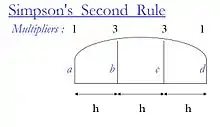Simpson's rules (ship stability)
Simpson's rules are a set of rules used in ship stability and naval architecture, to calculate the areas and volumes of irregular figures.[1] This is an application of Simpson's rule for finding the values of an integral, here interpreted as the area under a curve.

Simpson's 2nd rule

Also known as the 1–3–3–1 rule, Simpson's second rule is a simplified version of Simpson's 3/8 rule.[3]
Simpson's 3rd rule
Also known as the 5–8–1 rule,[4] SImpson's third rule is used to find the area between two consecutive ordinates when three consecutive ordinates are known.[5]
This estimates the area in the left half of the figure for Simpson's 1st Rule while using all three pieces of data.
Use of Simpsons rules
Simpson's rules are used to calculate the volume of lifeboats,[6] and by surveyors to calculate the volume of sludge in a ship's oil tanks. For instance, in the latter, Simpson's 3rd rule is used to find the volume between two co-ordinates. To calculate the entire area / volume, Simpson's first rule is used.[7]
Simpson's rules are used by a ship's officers to check that the area under the ship's GZ curve complies with IMO stability criteria.
References
- Bryan Barass; D.R.Derett. Ship stability for Masters and Mates (PDF). United Kingdom: Elsevier Butterworth. p. 69.
- Rhodes, Martin (2003). Ship Stability for Mates/Masters. United Kingdom: Seamanship International. p. 70.
- Subramaniam, Capt. Harry. Nutshell series – Ship Stability III. Mumbai, India: Vijaya Publications.
- Donkum, Enkhuizen, Van (2010). ShipStability. Dokmar publications. ISBN 978-90-71500-15-2.
- Bhange, Archana Ashish (February 2017). "Simpson's Rules and It's Application in Ship Stability" (PDF). International Journal of Computer & Mathematical Sciences. 6: 7.
- Kitching, Capt. R.C.E. Introduction to Ship Stability. Canada: Starpath Publications.
- V.L. Belenky; N.B Sevastianov (2007). Stability and Safety of Ships. USA: The Society of Naval Architects and Marine Engineers. ISBN 0-939773-61-9.